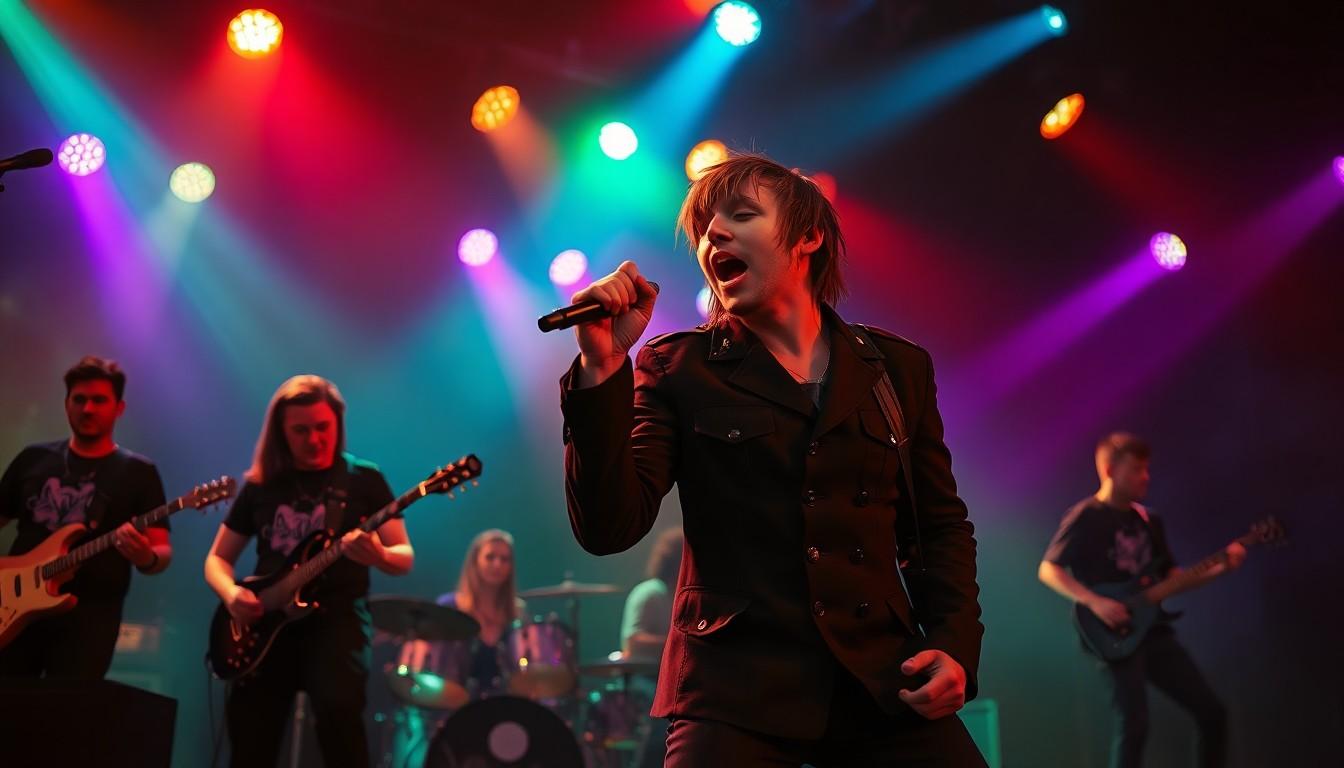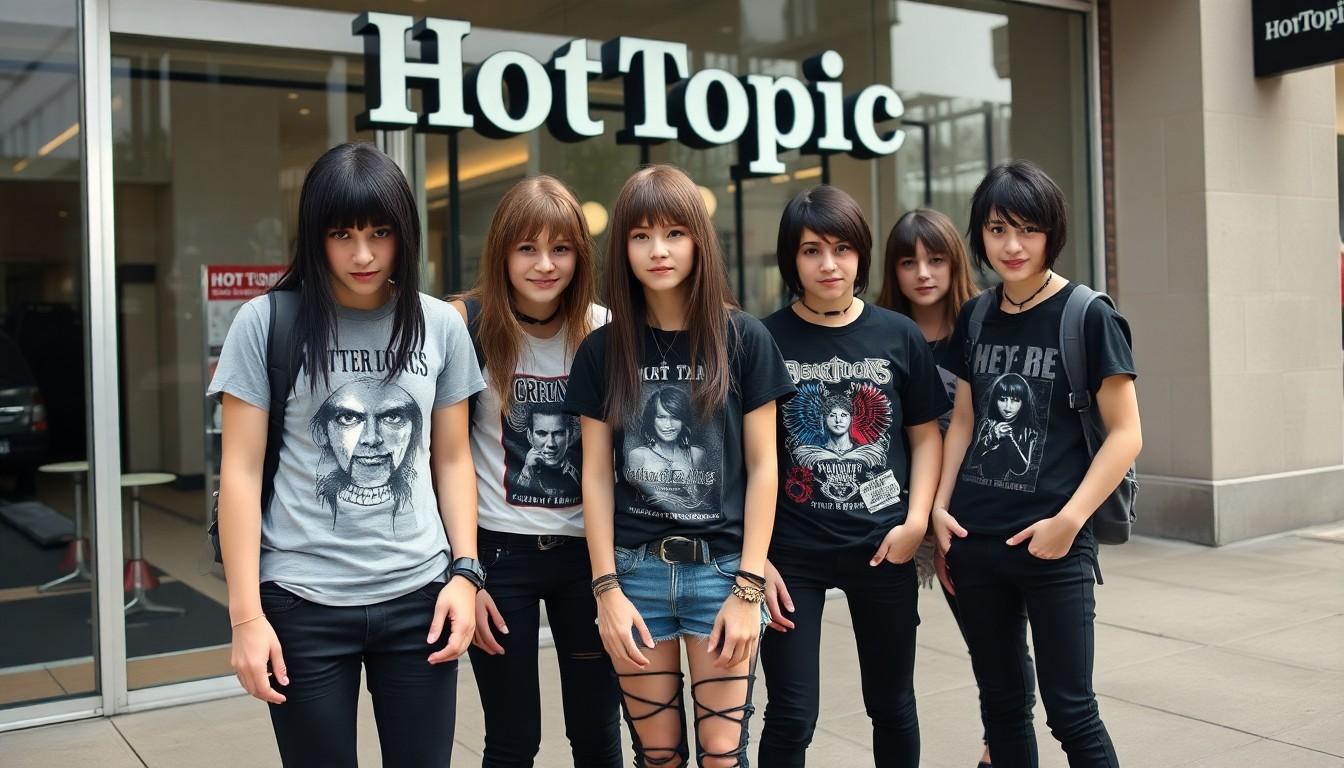The dark eyeliner, side-swept bangs and emotional lyrics of the mid-2000s emo movement captured the hearts of teenagers everywhere. From basement shows to stadium tours these bands transformed from underground sensations into mainstream rock stars while maintaining their raw emotional authenticity.
My Chemical Romance, Fall Out Boy and Panic! At The Disco led the charge bringing emo music to the masses. Their catchy hooks combined with introspective songwriting resonated with millions of fans seeking connection through music. The genre’s popularity exploded as Hot Topic became a cultural phenomenon and skinny jeans became the uniform of choice for a new generation of music lovers.
Popular Emo Bands
Emo music transformed from an underground punk subgenre into a mainstream cultural phenomenon during the mid-2000s. MTV championed emo bands through heavy rotation music videos leading to commercial success for groups like Taking Back Sunday, Dashboard Confessional My Chemical Romance.
Major record labels signed emerging emo acts between 2003-2007:
- Interscope Records acquired Jimmy Eat World
- Island Records signed Fall Out Boy in 2003
- Atlantic Records partnered with Fueled By Ramen for Panic! At The Disco
- Warner Bros. Records signed My Chemical Romance
The genre’s popularity reflected in significant album sales:
| Album | Artist | Year | US Sales |
|---|---|---|---|
| From Under the Cork Tree | Fall Out Boy | 2005 | 2.7M |
| The Black Parade | My Chemical Romance | 2006 | 3M |
| A Fever You Can’t Sweat Out | Panic! At The Disco | 2005 | 2.2M |
Emo aesthetics permeated teenage fashion through distinctive elements:
- Side-swept bangs covering one eye
- Black skinny jeans paired with studded belts
- Band t-shirts featuring emotional lyrics
- Converse shoes or Vans sneakers
- Heavy eye makeup for both male female fans
Hot Topic stores capitalized on the movement by expanding from 150 locations in 1999 to 690 stores by 2006. The retailer became a cultural hub for emo fans seeking band merchandise music accessories. Popular media outlets like Alternative Press magazine increased coverage of emo bands creating dedicated sections interviews features about the growing scene.
My Chemical Romance: Leaders of the Black Parade

My Chemical Romance emerged as a defining force in the emo movement after forming in New Jersey in 2001. The band’s theatrical performances, dark imagery, and emotionally charged lyrics established them as pioneers in the genre’s mainstream breakthrough.
Notable Albums and Chart Success
My Chemical Romance’s commercial breakthrough came with “Three Cheers for Sweet Revenge” (2004), selling 3.2 million copies worldwide. “The Black Parade” (2006) marked their creative peak, debuting at #2 on the Billboard 200 and achieving triple platinum status with sales exceeding 4.7 million units globally. The album’s lead single “Welcome to the Black Parade” topped the UK Singles Chart and reached #9 on the Billboard Hot 100. Their final studio album “Danger Days: The True Lives of the Fabulous Killjoys” (2010) showcased a shift toward alternative rock while maintaining commercial success with a #8 Billboard debut.
Cultural Impact and Legacy
My Chemical Romance’s influence extends beyond music sales into broader cultural movements. The band’s visual aesthetic inspired an entire generation’s fashion choices, from black parade jackets to red eyeshadow. Their music videos garnered over 100 million views on YouTube, establishing new standards for artistic expression in the genre. The group’s messages of self-acceptance resonated with millions of teenagers, creating dedicated fan communities across social media platforms. Their 2019 reunion announcement generated 5 million social media interactions in 24 hours, demonstrating their lasting cultural relevance. Leading music publications like Rolling Stone rank “The Black Parade” among the most influential rock albums of the 2000s.
Panic! At The Disco’s Evolution
Panic! At The Disco emerged from Las Vegas in 2004, signing to Fall Out Boy’s Decaydance Records. The band’s trajectory shifted from an experimental rock outfit to a pop music powerhouse, led by frontman Brendon Urie.
From Underground to Mainstream
Panic! At The Disco’s debut album “A Fever You Can’t Sweat Out” (2005) catapulted them from local obscurity to international stardom. The breakthrough single “I Write Sins Not Tragedies” reached #7 on Billboard Hot 100, selling 1.8 million copies. Their early success sparked a dedicated following, with the debut album achieving double platinum certification by 2006. The band performed at major festivals including Reading Festival Leeds Festival within their first year of mainstream exposure. Their theatrical live shows featured baroque-inspired costumes circus performance elements, distinguishing them from contemporary emo acts.
Musical Style Changes
| Album Era | Primary Musical Style |
|---|---|
| 2005-2007 | Baroque Pop-Punk |
| 2008-2010 | Psychedelic Rock |
| 2011-2015 | Alternative Dance |
| 2016-2022 | Pop Rock/Jazz Pop |
Fall Out Boy’s Journey
Fall Out Boy emerged from Chicago’s hardcore punk scene in 2001, founded by Pete Wentz and Joe Trohman. The band crafted a signature sound blending punk rock energy with pop sensibilities, catapulting them to the forefront of the emo movement.
Major Hits and Commercial Success
Fall Out Boy’s breakthrough album “From Under the Cork Tree” (2005) spawned two top-10 singles: “Sugar, We’re Goin Down” and “Dance, Dance.” The album achieved double platinum status, selling 2.7 million copies in the United States. “Infinity on High” (2007) debuted at #1 on the Billboard 200, featuring hit singles “This Ain’t a Scene, It’s an Arms Race” and “Thnks fr th Mmrs.” The band’s success continued with “Folie à Deux” (2008), which showcased their musical evolution through complex arrangements and diverse influences.
Hiatus and Comeback
The band announced an indefinite hiatus in 2009, allowing members to pursue individual projects. Patrick Stump released a solo album while Pete Wentz formed Black Cards. Fall Out Boy returned in 2013 with “Save Rock and Roll,” which topped the Billboard 200 and produced the 5x platinum single “My Songs Know What You Did in the Dark.” Their comeback solidified with “American Beauty/American Psycho” (2015), featuring the diamond-certified hit “Centuries.” The band maintains commercial success through consistent chart performance and sold-out arena tours.
Taking Back Sunday and Thursday
Taking Back Sunday and Thursday emerged as influential forces in the early 2000s emo scene, establishing distinctive sounds that blended post-hardcore intensity with emotional vulnerability. These bands helped bridge the gap between underground emo and mainstream rock success.
Early Emo Pioneers
Thursday formed in New Brunswick, New Jersey in 1997, releasing their breakthrough album “Full Collapse” in 2001 through Victory Records. The album produced signature tracks “Understanding in a Car Crash” and “Cross Out the Eyes,” reaching No. 178 on the Billboard 200. Taking Back Sunday formed on Long Island in 1999, gaining prominence with their 2002 debut “Tell All Your Friends.” The album sold 2,300 copies in its first week, growing to over 790,000 copies sold through word-of-mouth promotion. Their sound incorporated dual vocal attacks between Adam Lazzara and John Nolan, creating a template for future emo bands.
Influence on Modern Bands
Taking Back Sunday’s vocal interplay style appears in contemporary bands like The Wonder Years and The Story So Far. Their 2006 album “Louder Now” peaked at No. 2 on the Billboard 200, demonstrating emo’s commercial viability. Thursday’s dynamic song structures influenced post-hardcore bands including La Dispute and Touché Amoré. The raw production techniques used on Thursday’s “War All the Time” (2003) established recording standards for emotional hardcore music. Modern artists cite both bands’ authentic approaches to songwriting, with groups like Title Fight and Balance and Composure incorporating elements from their respective styles.
Jimmy Eat World’s Lasting Impact
Jimmy Eat World transformed from an underground alternative rock band into mainstream superstars through their innovative blend of power pop and emotional lyrics. The band’s influence spans multiple generations of musicians and fans since their formation in 1993.
Breakthrough with “The Middle”
“The Middle” catapulted Jimmy Eat World to international fame in 2001, reaching #5 on the Billboard Hot 100 chart. The track’s uplifting message resonated with audiences, earning platinum certification with over 1 million copies sold. The song appeared in numerous TV shows, commercials, and video games, including Guitar Hero World Tour and Rock Band. Their album “Bleed American” (later retitled “Jimmy Eat World”) achieved platinum status, selling over 1.6 million copies globally. The music video gained heavy rotation on MTV, introducing the band’s signature sound to mainstream audiences.
Evolution of Sound
Jimmy Eat World’s musical journey spans from raw emo roots to polished alternative rock. Their 1994 debut “Jimmy Eat World” featured punk-inspired energy, while 1996’s “Static Prevails” incorporated melodic elements. “Clarity” (1999) marked a shift toward layered compositions with atmospheric production. Post-breakthrough albums like “Futures” (2004) and “Chase This Light” (2007) balanced radio-friendly hooks with intricate arrangements. The band’s production techniques influenced modern indie rock acts like The Killers and Paramore. Their recording approach at Tempe’s Unit 2 Studio created a template for capturing emotional intensity in studio settings.
Paramore’s Pop-Emo Fusion
Paramore emerged as a distinctive force in the emo scene with their blend of pop-punk energy and emotional vulnerability. Led by vocalist Hayley Williams, the band carved out a unique space in the genre by combining catchy melodies with raw authenticity.
From Riot! to Present Day
Paramore’s breakthrough album “Riot!” (2007) established their signature sound with platinum-certified singles “Misery Business” reaching #26 on Billboard Hot 100 and “That’s What You Get” hitting #66. The band evolved through “Brand New Eyes” (2009) which debuted at #2 on Billboard 200 selling 175,000 copies in its first week. Their self-titled album “Paramore” (2013) marked a shift toward pop with “Still Into You” achieving triple platinum status. “After Laughter” (2017) showcased their transformation into new wave pop while maintaining emotional depth throughout tracks like “Hard Times.” Their recent album “This Is Why” (2023) debuted at #2 on Billboard 200 demonstrating their continued commercial success.
| Album | Year | Peak Billboard Position | Certification |
|---|---|---|---|
| Riot! | 2007 | #20 | 2x Platinum |
| Brand New Eyes | 2009 | #2 | Platinum |
| Paramore | 2013 | #1 | Platinum |
| After Laughter | 2017 | #6 | Gold |
| This Is Why | 2023 | #2 | – |
Modern Emo Revival
The emo genre experienced a resurgence in the 2010s through bands like The World Is a Beautiful Place & I Am No Longer Afraid to Die, Modern Baseball, and Tigers Jaw. American Football’s reunion in 2014 sparked renewed interest in the genre, with their album “LP2” reaching #68 on the Billboard 200.
Title Fight bridged hardcore punk with shoegaze elements on their 2015 release “Hyperview,” expanding emo’s sonic boundaries. The Wonder Years evolved from pop-punk roots to create emotionally complex albums like “The Greatest Generation” (2013) which peaked at #20 on the Billboard charts.
Notable releases during this period include:
| Band | Album | Year | Peak Chart Position |
|---|---|---|---|
| Modern Baseball | Holy Ghost | 2016 | #57 Billboard 200 |
| The Hotelier | Home, Like Noplace Is There | 2014 | #3 Heatseekers |
| Tigers Jaw | spin | 2017 | #129 Billboard 200 |
La Dispute pioneered a spoken-word emo style with “Rooms of the House” (2014), inspiring bands like Touché Amoré to incorporate similar narrative approaches. Tiny Moving Parts gained recognition for their technical math-rock influenced emo sound, demonstrated on their album “Celebrate” (2016).
Contemporary acts like Spanish Love Songs Real Friends Joyce Manor maintain emo’s DIY ethos while incorporating modern production techniques. Microwave combines southern rock elements with emo sensibilities creating a distinct sound on albums like “Much Love” (2016).
The revival movement emphasizes raw emotional authenticity authenticity connection to emo’s original underground roots rather than its mainstream mid-2000s incarnation. Labels like Run For Cover Records Triple Crown Records support these emerging artists preserving the genre’s independent spirit.
The emo movement of the mid-2000s left an indelible mark on music history with bands like My Chemical Romance Fall Out Boy and Panic! At The Disco leading the charge. These artists didn’t just create music; they sparked a cultural revolution that influenced fashion youth culture and the entire music industry.
Today’s emo revival shows the genre’s enduring appeal with new bands carrying forward the emotional authenticity that made it powerful in the first place. While the skinny jeans and side-swept bangs might be less common now the raw emotional expression and musical innovation continue to resonate with new generations of fans.
The legacy of these pioneering emo bands extends far beyond their chart success. They’ve inspired countless musicians paved the way for more open expressions of emotion in rock music and proved that authenticity can coexist with mainstream success.

